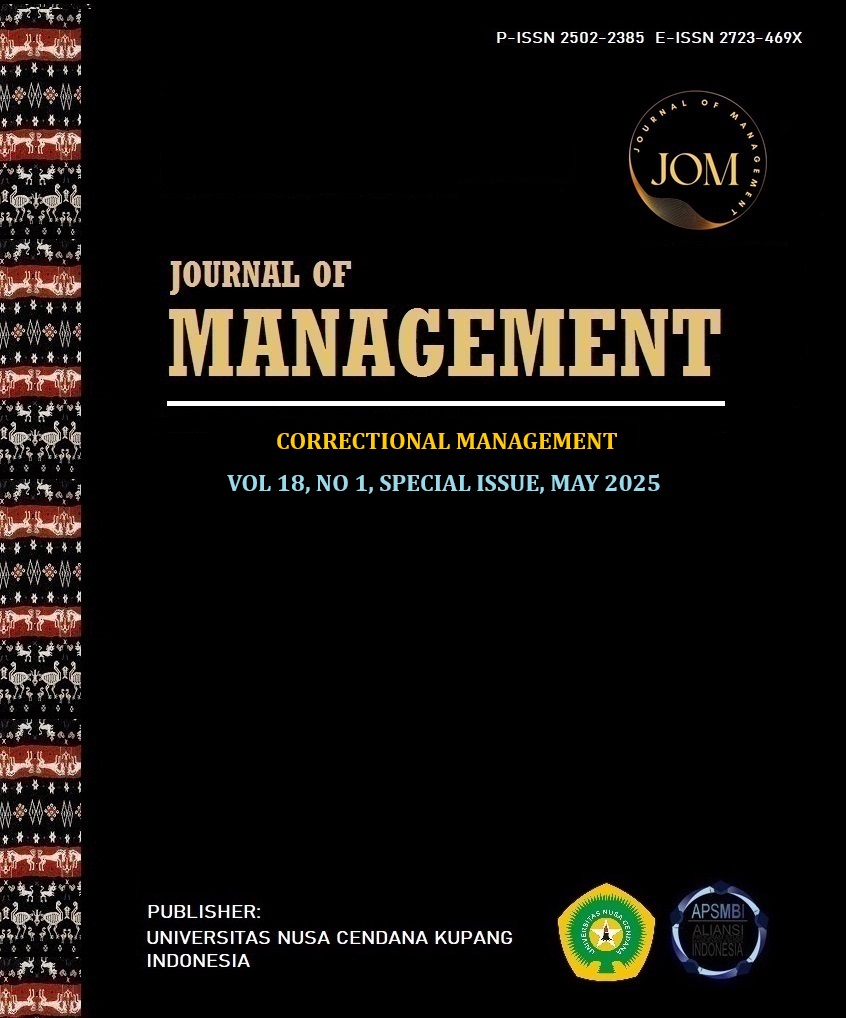EARLY DETECTION IN PREVENTING DRUG CONTROL IN CLASS IIA CIKARANG CORRECTIONAL FACILITY
Abstract
A crisis is an urgent and unexpected situation that can threaten the integrity and well-being of an organization. In the context of correctional institutions, the risk of a crisis, such as a fire, is ever-present. This research explores the Directorate General of Corrections' response to the fire at Tangerang Class 1 Correctional Facility in 2021, which killed 49 inmates and caused major material losses. The analysis focuses on the crisis communication strategies implemented to address the negative impacts and restore public trust. Through qualitative research methods involving interviews and document studies, and using the theories of Situational Crisis Communication Theory and Image Repair Theory, this study examines the effectiveness of the communication strategies used. The findings show that the Directorate General of Corrections successfully implemented a swift, transparent, and coordinated communication strategy, which included the establishment of a Special Crisis Response Team, the selection of competent spokespersons, and quick clarification of circulating information. However, a major challenge remains in managing the dominant negative perceptions in the media. With a well-planned communication strategy and appropriate training, the agency can be better prepared and responsive in facing future crisis challenges.
Keywords: Crisis Communication Strategy; Early Detection; Drug Control
Downloads
References
https://doi.org/10.36679/ulr.v6i1.37 janggih,
Anggreiny, N., & Sarry, S. M. (2018). 9(2), 160.
https://doi.org/10.24036/rapun.v9i2.102212
Hardianto & Nurul (2018). Standar Pencegahan Gangguan Keamanan dan Ketertiban Lapas dan Rutan.
Handika, D. (2021). Optimalisasi Fungsi Satuan Intelijen Keamanan Dalam Penyelidikan Tindak Pidana Narkotika Yang Dilakukan Oleh Anggota Polri. Sol Justicia, 4(2), 214–221. https://doi.org/10.54816/sj.v4i2.463
Harefa, H. (2018). Kepolisian ( Studi Sat Intelkam Polres Solok ) The Police Intelligence Function And Constraints In The Investigation Of Narcotics Crimes Functions . The Specifications Of This Study Are Analytical Descriptive . While The Method Of. 1(1), 44–52.
Harefa, H. (2002). Tinjauan tentang Intelijen. 2, 1–64.
Made, N., Karma, S., Hukum, F., & Warmadewa, U. (2023). Optimalisasi Intelijen Kejaksaan Dalam Pelaksanaan Pidana Narkotika Dan Pencucian Uang. 4(2), 166–171.
Moleong. (2023). Metode Penelitian. Jurnal Wahana Bina Pemerintahan, 10(1), 42–56. https://doi.org/10.55745/jwbp.v10i1.118
Nabiela. (2019). Upaya Pemerintah Indonesia dalam Menurunkan Angka Peredaran Narkotika di Indonesia yang Dilakukan oleh Pengedar AsingTahun 2014-2016. Journal of International Relations, 5(1), 1074–1081.
Rinaldi. (2022). penempatan narapidana kasus narkotika di lapas. Penempatan Narapidana Kasus Narkotika Di Lapas, 4, 11438–11444.
Samsul, H. (2019). Pengamanan Pada Lapas Dan Rutan. Modul Pengamanan Pada Lapas Dan Rutan, 53(9), 1689–1699.
Setiawan, I. B. T., Widiati, I. A. P., & Sudibya, D. G. (2020). Peranan Badan Narkotika Nasional (BNN) Dalam Upaya Pencegahan Terhadap Tindak Pidana Narkotika. Jurnal Analogi Hukum, 2(3), 361–365. https://doi.org/10.22225/ah.2.3.2517.361-365
Siregar, Q. (2014). Komunikasi dalam Kinerja Intelijen Keamanan. Jurnal Sosioteknologi, 13(1), 72–75. https://doi.org/10.5614/sostek.itbj.2014.13.1.8
Travis, H. (1969). Causes Of Delinquency
Wahyu, S. (2018). Intelijen : Teori Intelijen Dan Pembangunan Jaringan
Yuska, S., & Firdaus, M. Y. (2022). Optimalisasi Peran Intelejen Pemasyarakatan Dalam Deteksi Dini Gangguan Keamanan Dan Ketertiban Di Rutan Kelas II B Situbondo. Jurnal Pendidikan Dan Konseling, 4, 8326–8337.

 Muhammad Fadhil Adi Nugroho(1*)
Muhammad Fadhil Adi Nugroho(1*)



